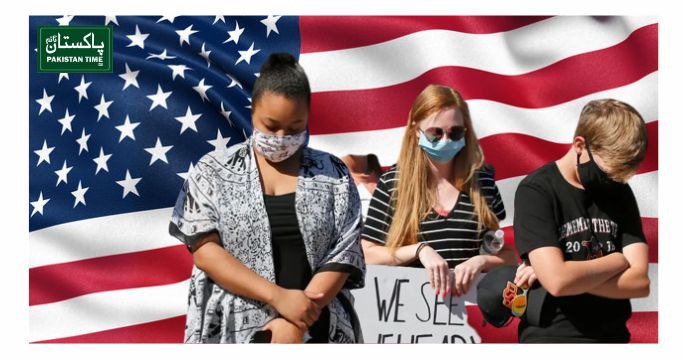Unraveling the “Greatest Conspiracy Against Americans”: The Origins, Influence and Role of the Media’’
Introduction:
Conspiracy theories have a deep-rooted history that has captured the imagination of people across cultures and generations. The “Greatest Conspiracy Against the American People” is one such confusing theory, which claims that a shadowy group of powerful elites secretly controls the nation’s destiny and shapes events to suit their interests. Although conspiracy theories have long fascinated and divided society, it is imperative to approach them with a clear mind and distinguish between evidence-based claims and baseless speculation. The origins of this conspiracy theory can be traced back to the early days of the United States, where notions of secret societies such as the Illuminati and the Freemasons are said to have influenced the course of the nation’s history. Over time, the story has evolved to incorporate contemporary events and social changes to maintain its charm and relevance. In recent years, the digital age has created fertile ground for the proliferation of conspiracy theories. Social media platforms, online forums and alternative media have become echo chambers where these theories can spread rapidly, reinforcing existing beliefs and further polarizing society. Psychological and sociological factors play a crucial role in the attraction of conspiracy theories. In a world full of complexity and uncertainty, conspiracy stories offer a sense of unity and empowerment by offering seemingly simple explanations for complex events. In addition, the political implications of conspiracy theories are significant. These narratives can fuel the rise of populist movements by portraying charismatic leaders as champions of secret elites. As public trust in institutions declines, individuals may become more susceptible to charismatic figures who use conspiracy theories for political gain, deepening social divisions and preventing constructive dialogue. The purpose of this blog is to explore the multifaceted aspects of “The Greatest Conspiracy Against Americans”, delving into its historical roots, the main proponents of its validity, the psychological factors behind its appeal, and the wider impact it has on the American society. It is very important to critically analyze conspiracy theories, promote media literacy, fact-checking and open dialogue to promote an informed public debate that encourages rationality rather than baseless speculation. By understanding the complexity of conspiracy theories, we can strive to build a more cohesive, informed and sustainable society that values critical thinking and evidence-based debate.
Origins and development of the conspiracy:
As the conspiracy theory has evolved over the years, it has adopted several elements to remain relevant and appealing to audiences. One notable addition was the inclusion of technological advances and their supposed role in furthering the conspiracy. Proponents argue that advances in surveillance technology, artificial intelligence and data analytics have given conspirators unprecedented control over the masses. They argue that personal data collected through digital platforms is used to manipulate public opinion and influence political outcomes. The theory also used global events to bolster its narrative. For example, the rise of globalization and the ever-increasing interconnection of states has created fertile ground for speculation about a hidden global cabal orchestrating events on an international scale. The creation of supranational organizations such as the United Nations and the European Union has been interpreted as part of a conspiracy to consolidate power and control sovereign states. In addition, conspiracy theorists have used the effects of financial crises and financial crashes to fuel suspicions that financial elites are secretly manipulating markets for their own gain. In particular, the global financial crisis of 2008 raised suspicions about a small group of powerful individuals orchestrating an economic downturn to concentrate wealth and power. Social and political changes also influenced the development of conspiracy theories. The increasing polarization of societies, especially in the age of social media, has allowed conspiracy theories to flourish when they encounter echo chambers that reinforce and reinforce beliefs. Popular movements, on both the left and right of the political spectrum, have seized on the conspiracy narrative as a means of mobilizing their base. In recent years, the theory has become more neutral and different political factions have interpreted it according to their own agendas. Some supporters believe the plot is aimed at undermining conservative values and traditions, while others say it is aimed at dismantling progressive ideals. The growth of disinformation and disinformation in the digital age further fueled the theory’s development. As falsehoods spread unchecked on online platforms, the line between conspiracy theories and real concerns is blurring, making it difficult to separate fact from fiction. Overall, the development of “The Greatest Conspiracy Against the American People” illustrates its adaptability and flexibility in the face of changing times. Combining contemporary events, technological advances and social dynamics, the theory continues to fascinate people unfamiliar with the complexities of today’s world. As society evolves, so does the conspiracy, adapting to new challenges and incorporating new elements to maintain its charm.
Historical events and alleged cover-ups: Proponents of this conspiracy theory often cite historical events as “evidence” to support their claims. The assassination of President John F. Kennedy, the moon landing, and the 9/11 attacks are often cited as events in which conspirators allegedly engaged in deception and cover-ups. Conspiracy theorists question official accounts of these events and raise questions about government transparency and accountability. They often rely on selective interpretation of evidence and try to connect unrelated events to create a coherent conspiracy narrative.
Main characters and institutions
Main characters:
- Members of a secret society: Conspiracy theorists often consider members of secret societies, such as the Illuminati and the Freemasons, as the main perpetrators of the alleged conspiracy. These individuals are believed to have significant power and influence in global affairs and work in secret to manipulate governments and economies.
- Elites and powerful figures: According to the theory, the key players in the conspiracy are powerful families, corporations and influential individuals. These elites supposedly control important events and decisions, ensuring that their interests are protected at the expense of the general public.
- Political Leaders: Some versions of the conspiracy theory involve the involvement or manipulation of prominent political leaders in a secret conspiracy. These leaders can be seen as mere puppets promoting the interests of the alleged conspirators without the knowledge of the public.
- Media figures: Conspiracy theorists often accuse the mainstream media of conspiracy, spreading verified information and suppressing the truth. Media organizations are believed to be controlled through an alleged conspiracy to influence public perception in serving their agenda.
Institutions:
Government, both nationally and globally, is often seen as a key institution involved in the conspiracy. Conspiracy theorists claim that government agencies engage in covert actions and cover-ups to protect the interests of crypto conspiracies.
- Intelligence agencies: Secret intelligence agencies such as the CIA and MI6 are often associated with conspiracy theories. These agencies are believed to be involved in the execution and secrecy of the plots.
- Financial Institutions: Large financial institutions and central banks are accused of manipulating economies and markets to concentrate wealth in the hands of a select few. Economic crises are often seen as signs of their organized activity.
- International Organizations: International organizations such as the United Nations and the European Union are sometimes portrayed as instruments used by a covert conspiracy to promote global control and governance. It is important to note that the existence of such a conspiracy is highly speculative and concrete evidence is lacking. Although conspiracy theories often attract public attention, it takes critical thinking and evidence-based analysis to distinguish between baseless claims and fact.
Political implications and social division:
Conspiracy theories can have profound political consequences, leading to the emergence of populist movements and further polarization of society. When institutions are widely trusted because of the belief in grand conspiracies, people may be more receptive to charismatic leaders who use these stories for political gain. These leaders often present themselves as outsiders who challenge the established order, vowing to uncover the hidden truth and fight against alleged conspirators. Populist movements fueled by conspiracy theories can gain traction by exploiting public frustration and disillusionment. They tend to reject mainstream politics, advocate radical change and present themselves as defenders of the “ordinary people” against the “corrupt elite”. Such movements can develop from anti-establishment sentiments and create a divide between “us” and “them”, further ideologically polarizing society. The political consequences of conspiracy theories can be far-reaching and lead to the erosion of trust in democratic institutions. When people are convinced that the system is rigged and that their voices are not being heard, they may withdraw from the democratic process altogether, leading to lower voter turnout and a weakened democracy.
The role of media and journalism:
The role of the media in dealing with conspiracy theories is more than covering them; it involves a delicate balance between responsibility, accuracy and ethical considerations. Read more about the role of media and journalism in dealing with conspiracy theories here:
- Contextualizing Conspiracy Theories: The media should avoid presenting conspiracy theories in isolation and provide a broader context to understand them. It includes a discussion of the historical, social, and psychological factors that contribute to the popularity of such theories. By contextualizing conspiracy theories, journalists can help the public understand the underlying issues in a more nuanced way.
- Educating the public about media literacy: Promoting media literacy is crucial in combating misinformation and disinformation. Media organizations must take an active role in educating the public on how to critically evaluate information, verify sources and recognize the signs of false stories. Media literacy programs can empower the public to distinguish credible information from unsubstantiated claims, thereby reducing the spread of conspiracy theories.
- Collaboration with conspiracy theorists: Journalists should interact with conspiracy theorists in a respectful and non-confrontational manner. By understanding their concerns and grievances, journalists can address the underlying issues and present evidence-based counterarguments. Open dialogue can foster mutual understanding and bridge the gap between conspiracy theorists and mainstream views. Debunking Conspiracy
- Theories with Evidence: Fact-checking plays a key role in debunking conspiracy theories. Journalists must rigorously investigate claims, verify sources and present evidence-based information to counter false stories. However, the approach should be constructive rather than adversarial, as an aggressive breach can sometimes strengthen believers in their beliefs.
- Ethical reporting and harm reduction: Media organizations have a duty to consider the potential harms of spreading conspiracy theories. While reporting them may be necessary to inform the public, it is important to balance coverage to avoid sensationalism. The media should avoid promoting conspiracy theories without proper context or verification.
- Transparency and accountability: Maintaining transparency and accountability in reporting is paramount. The reporter must clearly state his source, acknowledge the potential limitations of the evidence, and be open to correction if errors occur. Transparent reporting increases public trust and increases the credibility of media organizations.
- Avoiding the creation of dangerous conspiracies: Media organizations must carefully consider whether the dissemination of dangerous or harmful conspiracy theories is in the public interest. While providing diverse perspectives is essential, some conspiracies can incite violence or perpetuate harmful stereotypes. A responsible media should exercise discretion in presenting such stories.
- Avoiding a “false balance” approach:
Equal weighting of conspiracy theories and evidence-based information can create a false sense of equivalence. Journalists should avoid falling into the false balance trap of presenting conspiracy theories alongside well-supported facts, thereby giving undue credence to baseless claims.
- Stimulating Critical Thinking: Mass media plays a key role in fostering critical thinking among its audience. By providing comprehensive and evidence-based coverage, journalists can encourage audiences to question and critically analyze information. This allows people to make informed decisions and resist the allure of conspiracy theories.
- Fact-checking and disclosure: Journalists and media organizations should actively participate in fact-checking and debunking misinformation and conspiracy theories. This requires a thorough investigation of allegations, consultation with experts, and the presentation of evidence to refute baseless stories.
- Working with experts: When dealing with conspiracy theories, it is important to consult with subject matter experts, scientists and researchers. Experts can provide valuable information and context, helping journalists deliver accurate and well-informed stories.
- Ethics in Social Media Reporting: Social media platforms play an important role in spreading conspiracy theories. Media organizations must follow ethical guidelines when reporting on social media platforms. Avoiding catchy headlines and misleading content can help prevent the unintentional spread of conspiracy theories.
- Communication with the public: The media must actively engage with the public to address issues, answer questions and provide clarifications. Creating an open and honest dialogue can build trust and promote better understanding of complex issues.
- Avoiding fear: Reporting conspiracy theories that incite fear or panic can have serious consequences. The media must be careful about the possible influence of the language used and the reporting on public perceptions and behavior. By adopting these practices, the media can play a crucial role in combating the influence of conspiracy theories and promoting an informed public debate. Responsible journalism, critical thinking and evidence-based reporting are essential to promoting a society that values truth and rational debate.
Psychological factors and belief in conspiracy theories:
Research in psychology has revealed the psychological factors that contribute to the attraction of conspiracy theories between individuals. These factors go beyond mere curiosity or skepticism and dig deeper into the human psyche, revealing why some people are more prone to conspiracy thinking. Here are some key psychological factors that play a role:
- Feeling powerless: Individuals who feel powerless or powerless may be drawn to conspiracy theories to regain a sense of control. Belief in a grand conspiracy can provide a narrative to explain why they feel excluded or left behind, and their struggles stem from the malevolent actions of a mysterious group rather than complex social, economic or political forces.
- Uncertainty and Ambiguity: People naturally feel uncomfortable with uncertainty and ambiguity. Conspiracy theories offer a seemingly coherent and definitive explanation for complex events, providing clarity and reassurance in an otherwise chaotic world. This attraction can be particularly strong during times of crisis or social upheaval.
- Cognitive bias: Cognitive biases such as confirmation bias and selective attention can affect the way people process information. People may be more likely to seek out and believe information that confirms their existing beliefs, while rejecting or ignoring conflicting evidence. This selective understanding reinforces their belief in conspiracy theories.
- The need to recognize patterns: Humans have an innate tendency to recognize patterns and connections, even when there may not be any. Conspiracy theories are often based on linking apparently unrelated events, which encourages the perception of a secret or coordinated work.
- Need for identity and belonging: Believing in conspiracy theories can give people a sense of belonging to a like-minded community or group. Engaging in conversations and sharing conspiracy-based beliefs can create social bonds and strengthen identity.
- Epistemic beliefs: Epistemic beliefs refer to an individual’s understanding of knowledge and how it is acquired. Those with little faith in established institutions such as government, the media, or academia may be more inclined to seek alternative explanations outside of conventional narratives.
- Emotional Coping Mechanisms: Conspiracy theories can act as an emotional coping mechanism, especially in response to traumatic events or tragedies. Embracing a conspiratorial narrative can provide a way to make sense of troubling events and reduce feelings of vulnerability or fear.
Conclusion:
Conspiracy theories, including The Greatest Conspiracy Against the American People, have a long presence in human history, captivating minds and polarizing societies. It is important to approach these stories critically, with skepticism and a commitment to evidence-based analysis. While some conspiracy theories may stem from a genuine concern for transparency and accountability, others thrive on baseless speculation, misinformation and fearmongering. “The Greatest Conspiracy Against the American People” is a complex theory that claims that a secret group of powerful elites controls the fate of the nation. Its origins can be traced back to notions of secret societies in the early days of the United States, and it has evolved over time to incorporate modern events, technological advances, and social changes. The digital age has created fertile ground for the spread of conspiracy theories, which have strengthened their influence through social media echo chambers and alternative media platforms. The political implications of conspiracy theories are profound. They can encourage the emergence of populist movements and further polarize society by presenting charismatic leaders as protectors against alleged conspirators. As public trust in institutions declines, individuals may be more vulnerable to actors who use conspiracy narratives for political gain, preventing constructive dialogue and deepening social divisions. The media and journalism play a crucial role in the responsible use of conspiracy theories. Responsible reporting, fact-checking and open dialogue are essential to combating the spread of misinformation and disinformation. Journalists should resist sensationalism, avoid false balance and promote media literacy so that the public can distinguish reliable information from baseless claims. When dealing with conspiracy theories, it is important not to ignore the genuine concerns expressed by individuals, but to have a respectful dialogue to understand their grievances. Contextualizing conspiracy theories and gaining a broader understanding of their historical, social, and psychological factors can help audiences develop nuanced perspectives. Promoting transparency, accountability and cooperation with reporting experts can increase public trust in media organizations. By verifying and disproving false information, journalists can contribute to a well-informed public debate and counter the influence of conspiracy theories. In conclusion, we can say that conspiracy theories will probably continue to be part of public debate. While some may offer alternative perspectives or criticize government actions, others may be harmful, divisive and undermine trust in institutions. Responsible journalism, media literacy and critical thinking are essential to navigating the complex landscape of conspiracy theories. By growing a society that values evidence-based analysis, rational debate and open dialogue, we can strive to create a more cohesive, informed and sustainable community. As individuals, media organizations and institutions, it is our common duty to value the values of truth, openness and honesty in the pursuit of a more informed and united society.






